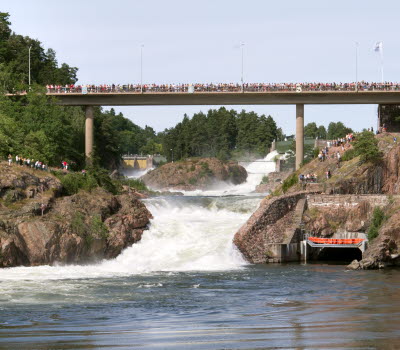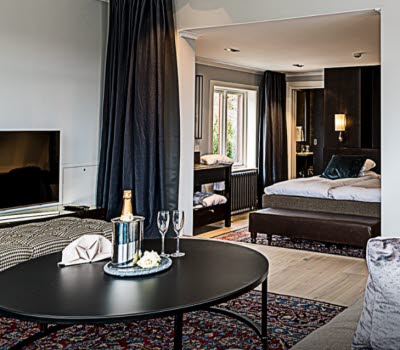Cemetary Walk
Västra Tunhem
Churches and cemeteries nurture personal memories and a common cultural heritage. Join a walk in Västra Tunhem's cemetery and make a time travel to times gone by. Feel the wings of history and the history of the buried people.
Discover beautiful Västra Tunhem and its church and cemetery. Here are twelve poles placed next to the church and out in the cemetery with QR codes on. By scanning these codes, you will go directly to the pastorate's website where you can read more about the places.
The placement of the poles is marked with red dots on the map in this pdf.
HOW TO USE!
If you have a newer mobile phone, it may work to scan the QR code directly into the camera of the mobile. Try to keep the camera in front of the code, if a page appear with information then you have succeeded and you can just keep scanning and continue on the walk.
If nothing happens, you may need to download an app "Scan QR codes". Usually found where you download apps, for example in Appstore or Galaxy store.
Below you will find the places you will visit during your tour.
Photographer: Jan Andersson
Västra Tunhem's church
The church dates from the 12th century and is located at the foot of Hunneberg and is the mother church of Västra Tunhem's pastorate. Southeast of Västra Tunhem's church is Västra Tunhem's vicarage from the 1720s. It is one of Sweden's best-preserved vicarage environments, where many of the old outbuildings still remain.
Very close by is Western Sweden's oldest oak with more than 800 annual rings.
Photographer: Helen Wiik Andersson
Västra Tunhem's cemetery
The cemetery is located just below Hunneberg's steep west wall on Tunhemsslätten. Parts of the block were taken into use as early as the 12th century. In conjunction with the rebuilding of the church in the 15th century, the cemetery was expanded a bit to the east. 13 oaks were planted in connection with the expansion of the cemetery which was done in the 18th century. 10 years later, additional deciduous trees were planted in the cemetery.
Photographer: Västra Tunhems pastorat
The ceremony site
The ceremony site was founded in the early 1930s, it has an altar, a catafalque and a large cross. Here, burials can be performed in summer. An old tradition was to gather here on Mother's Day at the ceremony site and then have a short devotional moment.
Photographer: Västra Tunhems pastorat
Nikodemus Högberg's grave
Son of the school teacher Johan Högberg and Kerstin Jansdotter from Gärdhem. The poet Nikodemus Högberg was born on May 25, 1859 in Gärdhem and came to Uddevalla at the age of 14 to become a saddlemaker. He probably started writing poetry around 1877-1900 but also often ended up in trouble with justice.
Photographer: Västra Tunhems pastorat
The grave of the Forstena family
Here, the grave of the Forstena family was built with a surrounding mausoleum. Through an arched corridor, this was connected with the church. Lennart Torstensson's parents, Torsten Lennartsson and Märta Posse were buried here. The large tombstone bears the weapons of Forstena and Posse.
Torsten Lennartsson lived during the years 1561-1631 in Västra Tunhem, Forstena. He was appointed bailiff of Väne, Flundre and Ale districts and governor of Älvsborg Castle. In 1603 he took part in an organized uprising against Duke Sigismund III. The family fled but was pardoned in 1624 by Gustav II Adolf and returned to Sweden.
Photographer: Västra Tunhems pastorat
Ryding's graves
Six generations of Ryding rest here. Jonas Ryding, sheriff who served the crown for many years and eventually became a wealthy man and the area's largest landowner. His son Johan Ryding became district clerk in Väne bailiwick. Johan Fredrik Ryding, also a district clerk who advanced to become a county chamberlain. Tolf Gustaf Ryding who became both chairman and governor of Västernorrland County. Gösta Ryding who was employed by several different large companies, including in London.
Photographer: Västra Tunhems pastorat
Mrs. Louise Charlotte d'Orchimond's grave
Louise Charlotte d’Orchimont, F. Möller, b. 1835 in Uddevalla, daughter of the field chamberlain and knight, Hans Olof Malcus Skåne Möller and Anna Christina Lindström. Married to Lieutenant Carl Ferdinand Johan d'Orchimont. She died in November 1859 after a very difficult birth.
Louise Charlotte gets an elegant urn, with a wreath of half oak leaves (strength) and half bay leaves (victory) on her grave, maybe it even comes from abroad.
Photographer: Västra Tunhems pastorat
The grave of the unknown lime worker
Under this natural stone with a black drill, rests an unknown lime mill worker. Those who once made sure he got a stone, with the inscription "He rests here", for them he had a name. We do not know when he was born or died, was he young or old? Did he leave behind a wife and children?
But in all probability he worked with the risky work as a limestone worker, at one of the caves and limestone kilns along Hunneberg.
Photographer: Västra Tunhems pastorat
Magnus and Johanna Andersson's grave
The small portrait busts represent Magnus and Johanna. These were made by their son John (Johan) who was an artist. Between the years 1872 - 1898, they had 6 children, five boys and one girl of which four of them reach adulthood.
The eldest son John (Johan) Hedæus worked as a sculptor, illustrator, painter and graphic artist, and it is he who made the busts that adorn the parents' tombstone. He made many public decorations, including a large number of altar paintings.
Photographer: Västra Tunhems pastorat
Llewellyn Lloyd's grave
Llewellyn was born on July 27, 1792 in London, in one of London's more affluent aristocrat families, died in Vänersborg on February 17, 1876. His great passion was hunting but after problems with the law he moved from England to Sweden in 1819 and ended up in the vicinity of Värmland. Once here, it is again the hunt for game that makes him stay.
He lived in Värmland for almost 10 years before moving to Vänersborg in 1830, 38 years old. What attracts him then is above all the salmon fishing in Göta Älv. He therefore goes from being known as a bear hunter to becoming Sweden's first angler.
Photographer: Västra Tunhems pastorat
Ericsson's family grave
Carl Wilhelm Ericsson was born on September 28, 1840 in Åker in Gärdhem parish, son of the nationally known canal and railway builder Nils Ericsson and his wife Vilhelmina Schwerin. He became a lieutenant in the Västgöta regiment in 1858, served with honors in a zuav regiment in the war in Mexico 1863–1864 and happened to be robbed during the journey home, was left dying at the battlefield, but was later retrieved and recovered.
The family moves around most of the regiments and in the end they end up in Ängelholm. There, his wife Ebba Margareta Nyblaus died on December 30, 1918 and 10 years later, Carl also died and was taken to his final resting place here in Västra Tunhem.
Photographer: Västra Tunhems pastorat
Adolf Henrik Kloos grave
Adolf Henrik Kloo was born on February 10, 1878 in Ryda parish, Skaraborg county, he was the second oldest in a sibling group of 8 boys and 1 girl. It was not until the age of 18 that he became a student at Skara University in 1902.
When Adolf began his service as pastor here in Västra Tunhem, things happened in the parish. Both Sunday schools and youth groups were started and the adults became engaged in a new way. The result was sewing associations, small parish homes and also Västra Tunhem's local heritage association was started in 1936.
Västra Tunhems kyrka och kyrkogård
Kyrkstugan Pl 4580
461 93 Västra Tunhem
Phone: +46 521 26 58 50
Website: To homepage










